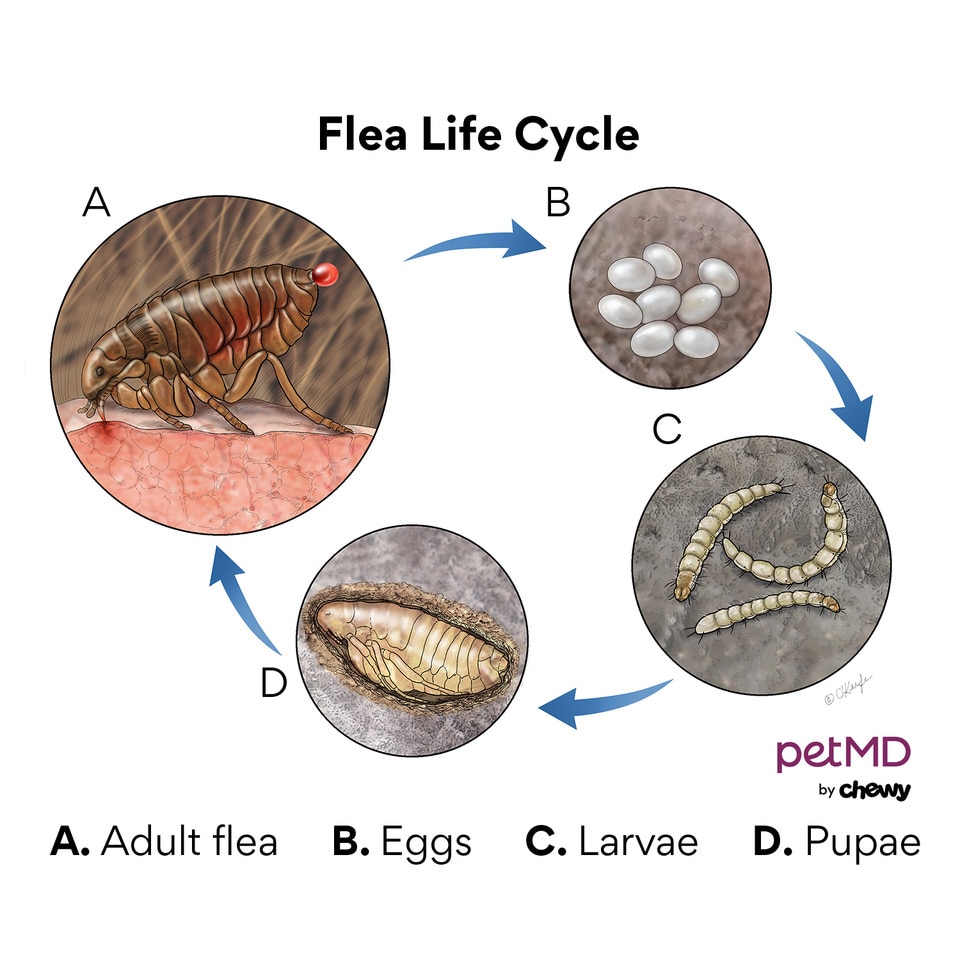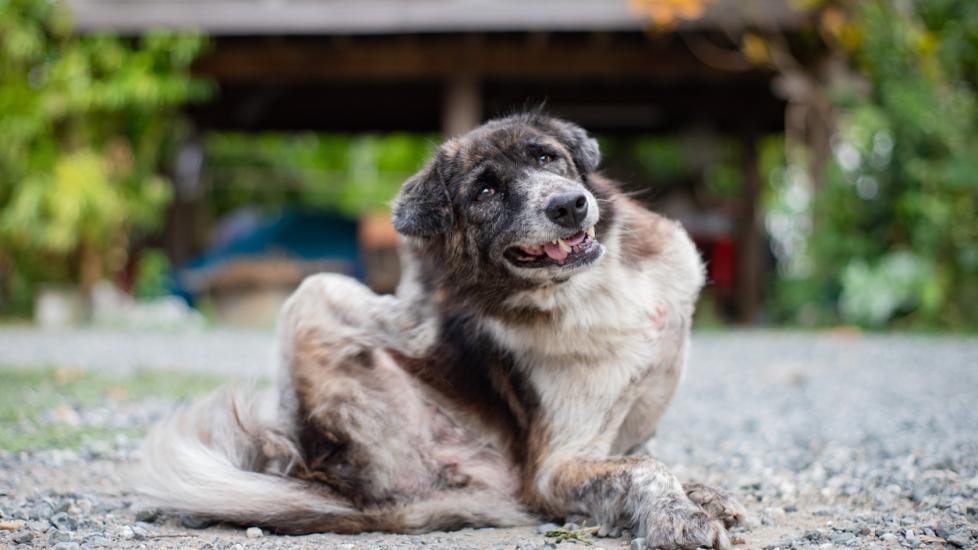How Do Dogs Get Fleas?
Maybe you’ve noticed a few tiny, dark insects scurrying through the fur of your pet. Perhaps your dog is losing some hair at the base of its tail, or you haven’t seen your pet itching, yet discovered red bumps on its ankles, feet, or lower legs.
Guess what? All these scenarios can signal the presence of fleas. Fleas are pesky little parasites that drink the blood of mammals. Their bite can be very uncomfortable and may even transmit disease. It is important to know if fleas are in your home and what you can do to solve the problem.
What Are Fleas?
Fleas are extremely common tiny parasites that are a bit smaller than a grain of rice (1/8 inch or up to 4 millimeters). They survive by drinking the blood of a host, which is usually a mammal (dog, cat, ferret, rabbit, human, etc.). There are fleas that can feed on other species such as birds, but fortunately, they do not cause any problems for pets. A flea’s life cycle is somewhat complex and has four stages: egg, larva, pupa (in a cocoon), and adult.
Fleas are most common during the warm months, however, they can survive winter inside a heated home. They are a year-round pest in southern states but only seasonal in the north. They can, however, be found almost anywhere in the United States, any time of year.
The primary driving factor of this cycle is temperature. During the cold months, it can take a flea more than 200 days to grow from an egg into an adult. This means that you need to treat your pets for a long time in the winter to protect against flea infestation—often as long as eight months. However, during the summer, the cycle is much quicker, and you may be able to rid your pet of any fleas in just two to three months with proper medication and treatment.

Ways Dogs Can Get Fleas
Dogs can get fleas in many ways. One way is through contact with other flea-infested dogs during a walk, romp at the dog park, or playdate at another pooch’s home.
Fleas can also “hitchhike” their way into your house by attaching to socks, pant legs, and shoes. Fleas can also jump tremendous distances! It isn’t impossible for a flea to jump through a screened-in window or door. If you aren’t using flea preventatives, it is more than likely your dog will become infested with fleas.
Let’s look at some of the common ways dogs can get fleas:
- Grass in the backyard: Dogs can catch fleas from the grass in your backyard, most often by other animals such as a raccoon, fox, or mouse, who walk through the area and transmit fleas to the ground.
These fleas or flea eggs fall into the grass and wait for their next meal. The flea might also jump on your clothes when you walk into the house, and you might unknowingly share it with your pet. It’s important to remember that fleas are excellent jumpers, so screen doors and windows aren’t a barrier.
- Other dogs: Does your dog meet other dogs at the park, during your daily walk, or at a playdate? Perhaps your dog stayed at the kennel for a weekend, or maybe a pet-parent friend visited and brought fleas from her home into yours.
These encounters may be hot beds for fleas. You can run, but you can’t hide! Fleas are everywhere.
-
Wildlife: The wildlife you love to see around your home, such as the squirrel that visits the bird feeder, or the coyote that stealthily wanders through the yard at night, can transmit fleas to your domestic pets.
-
Staying in new places: Has your dog visited a new place recently? Did you stay in a campground? Did you catch a car ride with a friend and brought your dog along? Did you leave your pup with a neighbor for the weekend? Each is a potential source of flea infestation.
-
Other pets: The source of the blame can also be the family cat. Cats catch fleas the same way as dogs. If your outdoor cat is properly treated with flea medication, they won’t be able to bring fleas into the house.
It is just as likely, however, that the dog passes the fleas to the cat as it is the other way around. Any mammal in the house that isn’t treated—including a guinea pig, rabbit, and ferret—could harbor fleas.
How To Check a Dog for Fleas
Even if you use a high-quality flea preventative on your dog, you should check Fido for fleas on a regular basis. This is quick and straightforward to do, and it should be part of your year-round routine, especially during warm weather.
My Dog Has Fleas. Now What?
Fleas are fortunately much easier to treat now more than ever. Many products are available, but they do vary in effectiveness. Also, with time, fleas develop a resistance to the parasiticides in flea medication, so it’s often necessary to upgrade to newer products, over time.
Your veterinarian might recommend a full array of options ranging from topical (preferred in many cases because they prevent fleas from biting your pet) to longer-acting oral products. Regardless of which product you choose, you will not effectively get rid of the fleas in your home unless all your pets are treated with flea medication.
If you treat the infected dog and not your other dogs, the fleas will just jump to the other dogs, who might never show symptoms of fleas until you spot them (typically only allergic animals get itchy). Treating the dog, but not the indoor cat, has the same results. Forget to treat the ferret? They get fleas too.
What is most frustrating is that each household pet will likely need a different flea medication because when it comes to fleas, there isn’t a one-size-fits-all solution. Tell your veterinarian about all animals in the house, so they can give you the most effective treatment plan.
Be Sure to Clean Your Environment
Frequently vacuuming carpets, rugs, and floors in your home will remove flea eggs and even some of the adult fleas and larvae. Concentrate on vacuuming areas where your pet goes the most but cover as much of the house as possible—even linoleum and hardwood floors.
Immediately after vacuuming, take the vacuum’s bag/canister outside and bag up the waste; otherwise, the fleas will jump out and back into the house.
Wash and dry all your pet’s bedding frequently. The heat of the dryer will also kill fleas and larvae.
Prevention of Fleas in Dogs
It is much easier to prevent fleas than to rid your pets and home of them. Year-round flea prevention products are necessary for most animals. Many products not only prevent fleas from infesting your pets, but also protect against ticks and even internal parasites. A little extra money spent now on prevention will protect you and your pets in the future.
How Do Dogs Get Fleas FAQs
Can humans get fleas from dogs?
Yes, the same fleas that bite dogs and cats can also bite humans. Although they seem to prefer furry companions, it is not uncommon for humans to be bitten—especially on the lower legs and feet if there is a flea infestation in the home.
Featured Image: iStock.com/Natee127
